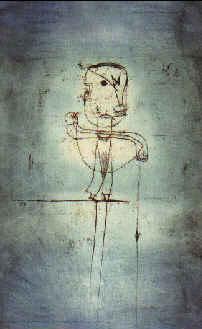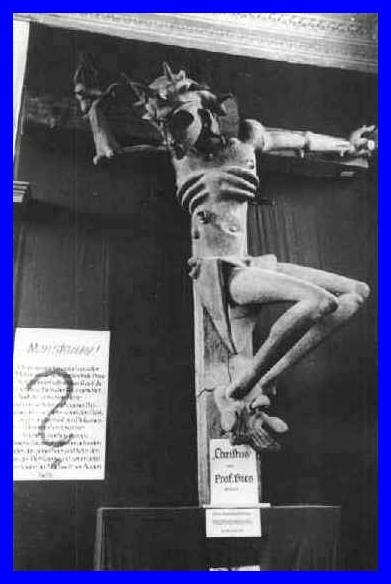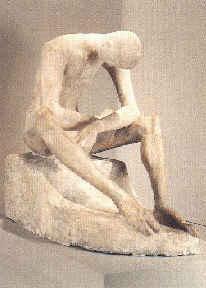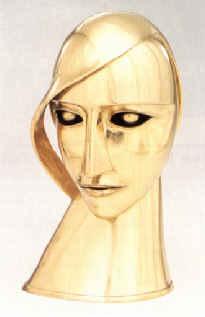 Emil Nolde, Crucifixion. 1 |
Degenerate Visual Arts - Painting and Sculptures
 Emil Nolde, Crucifixion. 1 |
Hitler developed his anti-semitism and suspicion of modern art in his early youth. As a young student artist in Vienna, Hitler had never taken to like modern art. He loved the nineteenth century, especially the works of the traditionalists Hans Makart, Anselm Feuerbach, and Ferdinand Waldm�ller, but knew nothing about innovators like Egon Schiele and Gustav Klimt. Hitler's approach to art was totally conventional and his attitude towards the art was one full of prejudice.2 This attitude was to be translated into full-fledged National Socialist Cultural Policy towards the visual arts in the Third Reich. This policy was to purge all modern art out in Germany and art that had any association with modernism, anti-semitism, and all other undesirable -isms.
Hitler took great care to link Jewishness with his other enemy, Marxism.
| "The bourgeois world is
Marxist, . . Marxism itself plans to transmit the world systematically into the
hands of the Jewry." Adolf Hitler 3 |
His belief in modern art was that it was the product of diseased minds, themselves the product of a degenerate race. The opposite of the shining Aryan was the dark Jew. Uncreative, driven only by commercial thoughts, the Jew was the archenemy of culture, the parasite, bare of any idealism, without cultural roots.4 Later on, when the purge of modern art became fanatical, especially during the years 1933-1937, all undesirable expressions of art, Modernism which was especially linked to the Jews and Cultural Bolshevism (see Section on Organisation and Control), Dadaism, Cubism, Futurism, Surrealism, and all other isms, except National Socialist Realism were classified under the general heading of "Degenerate Art". The Exhibition of Degenerate Art (Entartete Kunst) which opened in Munich on July 19, 1937 was a proof. In this exhibition, art works exhibited were the cream of anti-semitism, Cubism, Dadaism and Expressionism (see pictures below).5
Wassily Kandinsky, Two Complexes, 1928. 6 |
 Ernst Ludwig Kirchner, Self-Portrait as Soldier, 1915. 7 |
 Paul Klee, The Angler, 1921.8 |
To the National Socialists, these art movements were unGerman and although Modernism was very influential in Germany especially during the 1920s, the National Socialists charged it as art that was in constant association and vulgar depiction of decadent urban life and often depicting the women as prostitutes, as in Kirchner Self-Portrait as Soldier (see above). What the National Socialists wanted of women was a chaste life, an ideal human worthy of living.9 (see section on Ideal Sculpture)
 Oskar Kokoschka, The Tempest, 1914. 10 |
All art works that depicted the above themes were confiscated. Prominent German artists like Emil Nolde, Erich Heckel, Ernst Ludwig Kirchner, Otto Dix, Max Beckmann, Paul Klee, Wassily Kandinsky, Oskar Kokoschka (see above picture) and many others had their works confiscated and removed from art galleries and museums. In addition, foreign artists C�zanne (Impressionism), Vincent van Gogh (Fauvism), Paul Gauguin (Fauvism), Henri Matisse (Fauvism), Edvard Munch, Pablo Picasso (Cubism) and many others were on the National Socialists menu as well (see glossary).11 In total, more than five thousand works from private and public collections were seized. As only a small number of art works could be exhibited in the Degenerate Art Exhibition in 1937, the rest were burnt on March 20, 1939.12
 Ludwig Gies, Crucified Christ, 1921. 13 |
Sculptors Wilhelm Lehmbruck, Ernst Barlach, Rudolf Belling, Ludwig Gies and others suffered the same fate.
 Wilhelm Lehmbruck, Seated Youth, 1918. 14 |
 Ernst Barlach, Christ and John, 1926. 15 |
 Rudolf Belling, Head, 1925.16 |
The significance in the acts of confiscation and exhibition of degenerate art was to show to the German public that Germany was rid of her ills and the German Art was protected.8 The Degenerate Art Exhibition signified the end of the barbaric age.9 The other motive was of course to sell some of these "degenerate" art. It was reported that they netted more than 10, 000 pounds, 45,000 dollars and 8, 000 Swiss francs from the sale of some of these arts.10